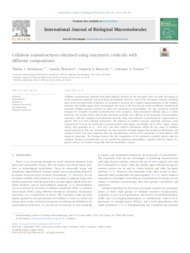Cellulose nanostructures obtained using enzymatic cocktails with different compositions.
Cellulose nanostructures obtained using enzymatic cocktails with different compositions.
Resumo: Cellulose nanostructures obtained from lignocellulosic biomass by the enzymatic route can offer advantages in terms of material properties and processing sustainability. However, most of the enzymatic cocktails commonly used in the saccharification of biomass are designed to promote the complete depolymerization of the cellulose structure into soluble sugars. Here, investigation was made of the way that the action of different commercially available cellulase enzyme cocktails can affect the production of nanocellulose. For this, enzymatic cocktails designed for complete or partial saccharification were compared, using eucalyptus cellulose pulp as a model feedstock. The results showed that all the enzymatic cocktails were effective in the formation of nanocellulose structures, with the complete saccharification enzymes being more efficient in promoting the coproduction of glucose (36.5 g/L, 87% cellulose conversion). The presence of auxiliary enzymes, especially xylanases, acted cooperatively to favor the production of nanostructures with higher crystallinity (up to 79%), higher surface charge (zeta potential up to − 30.9 mV), and more uniform dimensions within the size range of cellulose nanocrystals (80 to 350 nm). Interestingly, for the enzymatic cocktails designed for partial saccharification, the xylanase activity was more important than the endoglucanase activity in the production of nanocellulose with improved properties. The findings showed that the composition of the enzymatic cocktails already used for complete biomass saccharification can be suitable for obtaining nanocellulose, together with the release of a glucose stream, in a format compatible with the biorefinery concept.
Ano de publicação: 2022
Tipo de publicação: Artigo de periódico
Unidade: Embrapa Instrumentação
Observações
1 - Por padrão são exibidas publicações dos últimos 20 anos. Para encontrar publicações mais antigas, configure o filtro ano de publicação, colocando o ano a partir do qual você deseja encontrar publicações. O filtro está na coluna da esquerda na busca acima.
2 - Para ler algumas publicações da Embrapa (apenas as que estão em formato ePub), é necessário ter, no celular ou computador, um desses softwares gratuitos. Sistemas Android: Google Play Livros; IOS: iBooks; Windows e Linux: software Calibre.
Acesse outras publicações
Acesse a Base de Dados da Pesquisa Agropecuária (BDPA) para consultar o acervo completo das bibliotecas da Embrapa.

